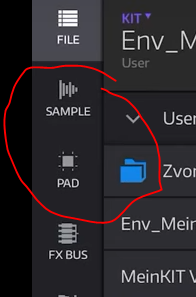Kitchen Sounds Sampling and a basic beat loop from it.
Yeah! I’m learning the ropes of creating your own audio samples (courtesy of Andrew Huang”s Music Production course). He uses Ableton, but we;re allowed to use any DAW we like—-I’m putting my eggs in NS2”s basket. NS2 is quite intuitive to use (with a some tutorial help online, of course, and the manual.)
This is a second revision of the loop—-the first one had so many timing errors (even while “on the grid”) because my audio samples apparently had too much from space before the sound. I learned that you can easily fix that in NS2: edit audio sample while in the Slate engine and easily saved too. I wish I could actually actually control the volume level in addition to “normalize.”

Comments
Oh shoot. That the 1st version posted above. I didn’t mean it.
HERE IS THE revised version>>.
Nice loops!
Two suggestions on techniques in NS2:
For volume levels in samples, you're probably better to normalize and then turn down the level in Slate, either under the Sample (letting you control the balance between samples for instance) or the Pad Amp settings tab. This way you've got better gain staging.

If you need to get perfect loop timing for a sample, for example recording external audio, the free version of Blocs Wave has synchronized loop recording. Just turn on Ableton Link in both apps so that they sync, then have your NS2 track playing in the background and record a loop in Blocs Wave. When you're happy with it, "export" that loop to NS2, move the sample from the Inbox to the Project (not strictly required but I always do it) then load that sample into an empty pad in Slate.
Sometimes though perfect timing is a bad thing, because you miss out on those cool grooves which come from natural timing. Which is something your loop does really well.
By the way, I think you might be better off using NS2 for the course than Live. I have both, and I think NS2 often lets you focus on the music better. Or that might just be me!
Wow Thanks for the suggestions! I discovered the normalize function, which makes things more, er, normalized across different samples indeed. Thanks for this suggestion—Ill make it my standard, rather than hit and miss. . I need to figure out what “gain staging” means — Ive seen it before. I understand what “gain” usually means in signals... halfway there.
. I need to figure out what “gain staging” means — Ive seen it before. I understand what “gain” usually means in signals... halfway there.
Thanks for the BLocs Wave recommendation. Oh, I didn’t want to learn Live because I cant afford it nor wish to get it, i have the Lite version (limited to 8 tracks, which I now know would be insufficient for a full song). So, Ive been using CAKEWALK By Bandland (fully functional and free!).
BUT THEN I discovered NS2 from a YouTube talking about top iOS DAWs and was playing with it, and was EASILY hooked. So I agree with you, NS2 will get you to make music quicker without too much diggin for how to do something in Live or even Cakewalk. I really liking Cakewalk as my second DAW for the PC desktop.
Gain staging is basically the practise of making sure that the audio signal is at an optimal level from the source through the entire signal chain. So, it isn’t loud enough to distort and it doesn’t gather up unwanted noise from being too quiet. Generally this is not a huge problem in NS because the internal processing is 32bit floating point, which means that it’s practically impossible to clip (distort) a sound until it gets to the OUT channel, which will clip if it shows red.
So, just remember, red on the OUT channel is bad. That’s the gist of it 😀
Aye!
@mrmein cool sampling;)
Thank you, Cray23
.